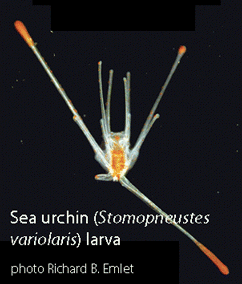New scientific newsstand for marine barcoders
 Identifying marine life is a major challenge. On land, nearly all animals visible without a microscope are in one of two phyla: Chordata or Arthropoda, the latter most often represented by insects. In contrast, many ancient lineages are present in the oceans. Abundant marine phyla with well-known representatives include Mollusca (molluscs), Porifera (sponges), Cnidaria (corals, jellyfish), Ctenophora (comb jellies), Echinodermata (sea urchins, others), as well as Chordata (e.g. fish) and Arthropoda (e.g. crabs). Many marine species have strange immature forms (see sea urchin larva above), which may puzzle specialists and others. Even marine vertebrates can be challenging. Using mitochondrial DNA, researchers recently discovered that what were thought to be three families of deep-sea fishes were in fact larval, male, and female forms of a single family of fish (Johnson Biol Lett 2009). Observation of marine life is difficult except in a few near shore areas. It is easier for a school child with a pair of binoculars to survey the moon than for a team of oceanographers with expensive equipment to study the deep ocean.
Identifying marine life is a major challenge. On land, nearly all animals visible without a microscope are in one of two phyla: Chordata or Arthropoda, the latter most often represented by insects. In contrast, many ancient lineages are present in the oceans. Abundant marine phyla with well-known representatives include Mollusca (molluscs), Porifera (sponges), Cnidaria (corals, jellyfish), Ctenophora (comb jellies), Echinodermata (sea urchins, others), as well as Chordata (e.g. fish) and Arthropoda (e.g. crabs). Many marine species have strange immature forms (see sea urchin larva above), which may puzzle specialists and others. Even marine vertebrates can be challenging. Using mitochondrial DNA, researchers recently discovered that what were thought to be three families of deep-sea fishes were in fact larval, male, and female forms of a single family of fish (Johnson Biol Lett 2009). Observation of marine life is difficult except in a few near shore areas. It is easier for a school child with a pair of binoculars to survey the moon than for a team of oceanographers with expensive equipment to study the deep ocean.
As with the enigmatic fish species described above, routine application of DNA-based identification will advance oceanographic science, and I imagine will have an even more transformative impact than in terrestrial research. To help establish the DNA reference library, we have the Marine Barcode of Life Initiative (MarBOL), a joint effort of Census of Marine Life (CoML) and Consortium for the Barcode of Life (CBOL), which aims to “enhance our capacity to identify marine life” through DNA barcoding. I note that PLoS ONE recently set up “The MarBOL Collection” of papers devoted to marine barcoding and look forward to seeing how this scientific “newsstand” develops. In June, PLoS ONE received an impact rating of 4.351, placing it in the top 25% percentile of biology journals, making it a prominent place for highlighting and disseminating scientific developments.
This entry was posted on Thursday, July 29th, 2010 at 2:36 pm and is filed under General. You can follow any responses to this entry through the RSS 2.0 feed. Both comments and pings are currently closed.
July 29th, 2010 at 4:03 pm
Parasites of marine organisms is a very challenging area, as well. I have been working with larval digeneans and nematodes of marine fishes, whose intermediate hosts are invertebrates (molluscs in the case of digeneans) and have found some affinities with GenBank sequences, but not that near as expected. That means there is probably an enormous wealth of species to be identified down there, and whose affinities are still not clear with other well-known parasites of marine life.